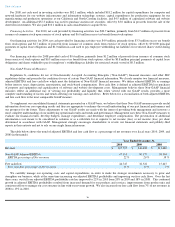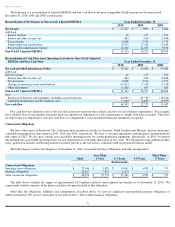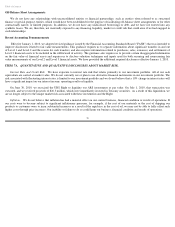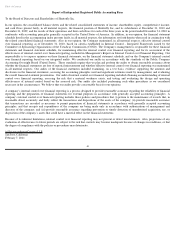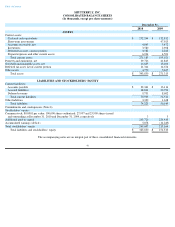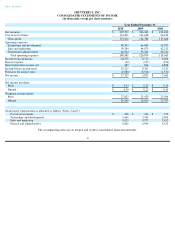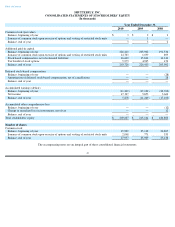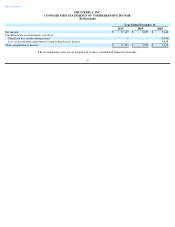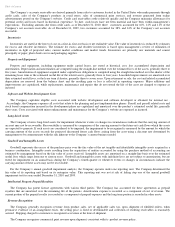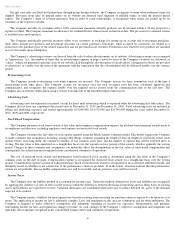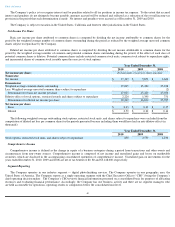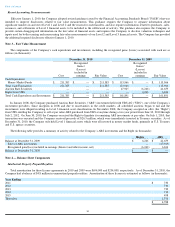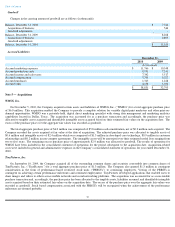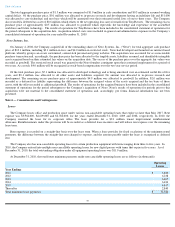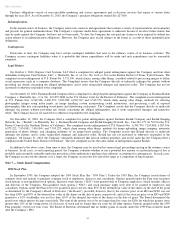Shutterfly 2011 Annual Report Download - page 53
Download and view the complete annual report
Please find page 53 of the 2011 Shutterfly annual report below. You can navigate through the pages in the report by either clicking on the pages listed below, or by using the keyword search tool below to find specific information within the annual report.
SHUTTERFLY, INC.
NOTES TO CONSOLIDATED FINANCIAL STATEMENTS
Note 1 — Description of Business
Shutterfly, Inc., (the “Company”)
was incorporated in the state of Delaware in 1999 and began its services in December 1999. The
Company is an Internet-
based social expression and personal publishing service that enables customers to share, print and preserve their
memories by leveraging a technology-
based platform and manufacturing processes. The Company provides customers a full range of products
and services to organize and archive digital images; share pictures; order prints and create an assortment of personalized items such as photo
books, greeting cards and stationery and calendars. The Company is headquartered in Redwood City, California.
Note 2 — Summary of Significant Accounting Policies
Principles of Consolidation
The accompanying consolidated financial statements include the accounts of the Company and its wholly-
owned subsidiaries. All
intercompany transactions and balances have been eliminated.
Use of Estimates
The preparation of financial statements in conformity with accounting principles generally accepted in the United States of America requires
management to make estimates and assumptions that affect the reported amounts of assets and liabilities and the disclosure of contingent assets
and liabilities at the date of the financial statements as well as the reported amounts of revenues and expenses during the reporting period.
Significant items subject to such estimates and assumptions include, among others, intangible assets valuation, useful lives, excess and obsolete
inventories, restructuring, and legal contingencies. Actual results could differ from these estimates.
Cash and Cash Equivalents
The Company considers all highly liquid investments purchased with original maturities of three months or less to be cash equivalents.
Management determines the appropriate classification of cash equivalents at the time of purchase and reevaluates such designations at each
balance sheet date. Cash equivalents consist of money market funds, primarily invested in U.S. Treasury and U.S. agency securities.
Short Term Investments
The Company reports its investments at fair value and assesses whether any impairment loss exists due to declines in fair value or other
market conditions. In 2009, the Company held auction rate securities (“ARS”)
that were classified as trading securities, which were recorded as
short term investments at December 31, 2009. Investments that the Company designates as trading assets are reported at fair value and gains or
losses resulting from changes in fair value are recognized in earnings. In 2010, all auction rate securities were liquidated, and the Company no
longer held any short term investments.
Fair Value
The Company records its financial assets and liabilities at fair value. The accounting standard for fair value provides a framework for
measuring fair value, clarifies the definition of fair value and expands disclosures regarding fair value measurements. Fair value is defined as
the price that would be received to sell an asset or paid to transfer a liability (an exit price) in an orderly transaction between market participants
at the reporting date. The accounting standard establishes a three-
tier hierarchy, which prioritizes the inputs used in the valuation methodologies
in measuring fair value:
Level 1 – Quoted prices in active markets for identical assets or liabilities
Level 2 –
Inputs other than Level 1 that are observable, either directly or indirectly, such as quoted prices for similar assets or liabilities;
quoted prices in markets that are not active; or other inputs that are observable or can be corroborated by observable market data for
substantially the full term of the assets or liabilities.
Level 3 –
Unobservable inputs that are supported by little or no market activity and that are significant to the fair value of the assets or
liabilities.
Concentration of Credit Risk
Financial instruments that potentially subject the Company to credit risk consist principally of cash, cash equivalents, and accounts
receivable. As of December 31, 2010, the Company's cash and cash equivalents were maintained by financial institutions in the United States
and its deposits may be in excess of insured limits. The Company believes that the financial institutions that hold its investments are financially
sound and, accordingly, minimal credit risk exists with respect to these investments.
Table of Contents
46


